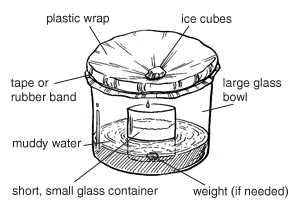Bursts of Energy...
Solar Energy Activity: "Solar-Powered Distillation"
Recommended grade levels: 2-6
Goal: Students will explore the role of the sun in the water cycle.
Process skills: Connections Observing Predicting
Frameworks: Universe
Materials: (for whole class demonstration, or per student group) one large glass or clear plastic bowl soil one small glass or bowl (shorter than the large bowl) one heavy object to weigh down glass clear plastic, masking tape or rubber band, water ice cubes or commercial freeze-pack (Blue Ice, Polar Ice, etc. ) heat lamp (optional)
Teacher background information:The water cycle is a continuous process. A very small percentage of all rainfall is taken up and used by plants. The remainder falls in the ocean, drains into rivers and lakes or seeps into the ground. Ground water eventually finds its way into rivers and back to the sea.
When sunlight warms water, some of the water evaporates into the atmosphere. The water vapor is blown about by the wind. The water vapor eventually cools, condenses and falls in droplets like rain.
In this activity, which can be a teacher demonstration or a teacher-led activity for groups of students, the water cycle and the direct use of solar energy will be observed. As the water in the bowl is warmed, some of the water evaporates. The ice cubes provide a cool surface for the evaporated water to condense in droplets. These water droplets collect on the plastic wrap. The ice cubes weigh down the plastic wrap so that the condensed water droplets are "funneled" into the glass. The empty glass will collect the clean water droplets that have formed on the plastic wrap.
Note: If a sunny place is not available, use a heat lamp instead. Many teachers have found this activity works with a 100 wall bulb in a goose neck lamp with a reflector shade (often included in science kits). Using a heat lamp will take longer time than when in direct outdoor sunlight.
Procedure: |
- Mix soil and water in a bowl to make muddy water.
- Place the empty glass, with heavy object inside, in the center of the bowl. Make sure the rim of the glass is above the muddy water. but below the bowl's edge.
- Cover the bowl with the plastic wrap and pull tightly. Fasten down with tape or rubber band.
- Place two or three ice cubes on the plastic wrap, directly above the glass. The wrap should dip down slightly, but not touch the glass. (see illustration). Ice cubes will need to be replaced periodically as they melt.
- Place the bowl in direct sun. After several hours, students should observe that clean water droplets have collected on the plastic wrap and in the glass.
Discussion:
- How did the water get into the glass?
- Was the water in the glass clean?
- What was the purpose of the ice cubes on top of the plastic wrap?
- How do solar energy and the water cycle clean the water?
Extensions:
- Have students experiment with placing one bowl in the shade and one in the sun.
- Have students discover what will happen with different bowls (different sizes, materials).
- Have students place a glass of salt water outside in the sun to observe what happens when the water evaporates.
Teacher resource:
Rickard, Graham. Solar Energy
Gr. 4-6. This book explains bow the sun, which is the ultimate source of energy on Earth, can be
used to provide electricity and power.
ISBN: 0-83-680709 X